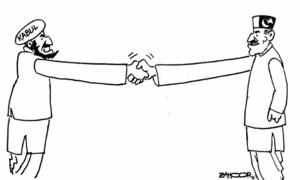
ISLAMABAD: Pakistan and the International Monetary Fund (IMF) on Thursday completed the $6.4 billion bailout programme on a successful note, paving the way for release of $102 million last tranche next month.
This is Pakistan’s first fund programme, out of 11, to have reached completion since it started receiving IMF bailouts in 1988. Pakistan had declined last two tranches of another programme under Musharraf-Shaukat Aziz tenure while all nine other programmes ended in failures.
At a joint news conference in Dubai, partially shown on the electronic media, Finance Minister Ishaq Dar and IMF Mission Chief to Pakistan Harald Finger announced successful completion of the 12th and final review of 36-month programme.
“After productive discussions, the mission and the Pakistani authorities have reached staff level agreement on the completion of the 12th and final review under the Extended fund Facility (EFF) arrangement. The agreement is subject to approval by the IMF management and the executive board. Upon completion of this review, SDR 73 million (about $102 million) will be made available to Pakistan,” said Mr Finger.
Conceding a couple of slippages in the last quarter ending June 30, 2016, Mr Dar termed as “highly satisfactory” the government performance throughout the programme that included a total of 13 waivers by the IMF since the programme was contracted in September 2013.
He said the successful completion of the last review was indicative of government’s strong commitment in implementing difficult structural reforms in the areas of taxation, energy, monetary and financial sectors and public sector enterprises. He also reiterated the government’s commitment “to successfully implement the macroeconomic stability programme announced by the government in June 2013”.
Talking about the programme performance in last quarter of 2015-16, the minister said the government met the end-June 2016 quantitative oerformance criteria on net international reserves, foreign currency swap/forward position, and government borrowing from the State Bank of Pakistan (SBP) by significant margins.
“The targets on net domestic assets and budget deficit were missed marginally,” he conceded.
Likewise, he said the indicative target for end-June 2016 on targeted cash transfers through BISP and on power sector arrears were also met. The Federal Board of Revenue (FBR), he said, not only achieved its original annual target of Rs3.104 trillion but exceeded it to reach Rs3.115tr — an unprecedented accomplishment — up 20pc. In the process, the figure of FBR’s tax-to-GDP ratio registered a substantial increase of one per cent to 10.5pc from 8.5pc in 2013, he said.
Mr Dar said the country achieved GDP growth rate of 4.71pc last fiscal year — highest in eight years and targeted to grow at 5.7pc this fiscal year and gradually steer to 7pc in 2017.
Sitting on his side, the IMF mission chief to Pakistan Mr Finger said growth was expected to reach 5pc next year even though challenging global environment and declining exports were weighing on growth prospects.
The minister said the industrial sector also recorded a growth of 6.8pc last year, highest in eight years and emphasised increase in fixed investment as welcome development along with improving electricity and gas supplies in the current fiscal year. “The CPEC will also play a significant role in further boosting economic activities,” he said.
The minister also highlighted Pakistan stock index to have touched 39,800 points early this week, saying this showed “robust economic activity and reflecting investor confidence”. He also claimed that external sector was stable on the back of continued flows from IFIs, low oil prices, rising remittances albeit at a slower pace, narrowing down current account deficit and foreign exchange stability.
With total reserves at over $23bn, the minister said net foreign exchange reserves of the central bank had increased from a low of negative $2.5bn at the start of the programme to $7.5bn at end-June 2016.
He said the banking sector was strong with capital adequacy ratio of 16.1pc against minimum requirement of 10.25pc but conceded the last year’s fiscal deficit standing at 4.6pc of GDP, well above the targeted 4.3pc. He said the government was continuously working to reform public sector enterprises focusing on improving their performance, reducing losses and improvement in service delivery.
Mr Finger put on record that even the final review was not without slippages. “All indicative targets and structural benchmarks were met, except for the delayed notification of multi-year tariffs for three power distribution companies”, he said.
Published in Dawn, August 5th, 2016










































